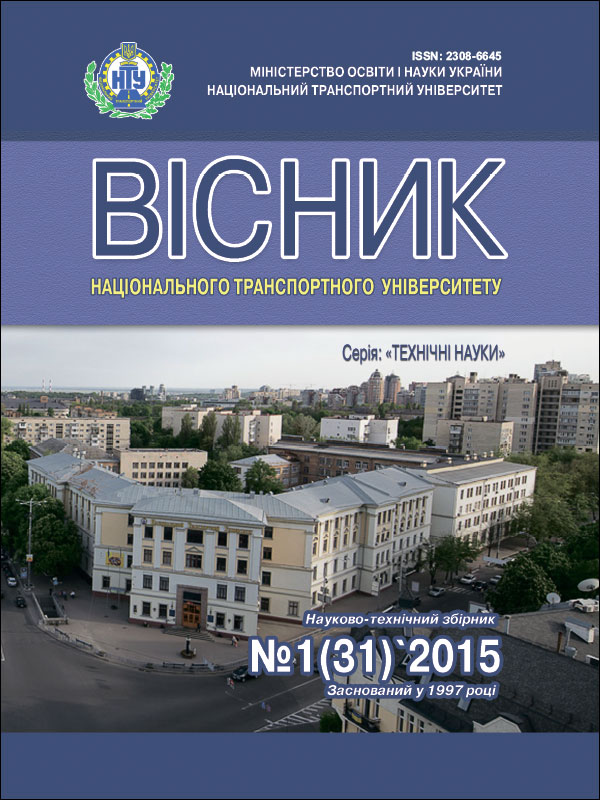THE CALCULATING MODEL OF AIR COMPRESSION PROCESS WITH LIQUID IN THE INTERNAL COMBUSTION ENGINE CYLINDER
ABSTRACT
Khrulev A.E., Dmitriev C.A. The calculating model of air compression process with liquid in the internal combustion engine cylinder. Visnyk National Transport University. Series «Technical sciences». Scientific and Technical Collection. - Kyiv: National Transport University, 2020. - Issue 1 (46).
The paper discusses the features and performs a preliminary analysis of the symptoms and the causes of the connecting rod damage of an internal combustion engine caused by liquid entering the cylinder (hydrolock).
Object of the study is the cylinder of an internal combustion engine when liquid enters it.
Purpose of the study is to research the mechanism of compression air with a liquid in the engine cylinder for identifying currently absent quantitative characteristics of the phenomenon of hydrolock, which causes deformation (buckling) and subsequent destruction of the connecting rod.
Method of the study is theoretical, includes the development of a methodology for calculating the variation of the air parameters during compression air with a liquid. Based on simplifying assumptions, a system of differential equations for the pressure and temperature of the air with a liquid in a cylinder is obtained from the equations of gas state and energy. The system is solved by numerical integration over the crankshaft rotation angle with initial conditions were obtained using the standard ICE cycle calculation software. As a result, computation of the cylinder pressure in compression process by the crankshaft rotation angle depending on the filling ration of the combustion chamber with liquid was performed.
The practical use of the methodology and the results obtained consists in their application in the problems of the engine damage simulation, including the calculations of the connecting rod buckling during hydrolock, as well as to clarify the symptoms and the causes of the damage.
By calculation using the developed methodology, it was found that with an increase in the amount of a liquid, the maximum pressure in the internal combustion engine cylinder rapidly increases during compression, starting with the combustion chamber filling ratio of 80%. With a further increase in liquid filling, commensurate with the volume of the combustion chamber, pressure rise in the final phase of the compression stroke is possible tens or even hundreds of times, which determines the damage to the connecting rod during hydrolock.
KEYWORDS: INTERNAL COMBUSTION ENGINE, ICE, CONNECTING ROD, CYLINDER, FAILURE, DAMAGE, HYDROLOCK, SIMULATION.
REFERENCES
- Greuter, E., Zima, S. (2012) Engine Failure Analysis. Internal Combustion Engine Failure and Their Causes. Warrendale, SAE International, 582 p. [in English].
- Engine components and filters. Damage profiles, probable causes and prevention. (2016) Technical information MS3-1109. Farmington Hills, Mahle Aftermarket Inc., 76 p. [in English].
- Khrulev, A.E., Kochurenko Y.V. (2017) Metodika opredeleniya prichiny neisprabnosti DVS pri tyajelykh ekspluatazhionnykh povrejdeniyakh [Method for determining the cause of the ICE failure for severe damages in operation]. Dvigateli vnutrennego sgoraniya - Internal Combustion Engines, 1, 52-60 [in Russian]. DOI: 10.20998/0419-8719.2017.1.10 [in Russian].
- Khrulev, A.E., Losavio, S.K., Drozdovsky, V.B. (2019) Expertiza tekhnicheskogo sostoyaniya i prichiny neispravnostey avtomobilnoy tekhniki [Technical condition expertise and automotive technology fault causes]. Moscow, Publishing house ABS, 966 p. [in Russian].
- Khrulev, A. (2000) Gidroudar v szilindre [Hydrolock in the cylinder]. Avtomobil i servis - Automobile and service, 4, 8-10 [in Russian].
- Khrulev, A., Samokhin, S. (2011) Gidroudar «otlojennogo deistviya» [Hydrolock «delayed ac- tion»] Avtomobil i servis - Automobile and service, 08, 36-39 [in Russian].
- Kumar, P.S., Kumar, K. (2016) Buckling Analysis and Shape Optimization of Connecting Rod using FEA. REST Journal on Emerging Trends in Modelling and Manufacturing, 2 (2, 44-50 [in English].
- Shenoy, P.S., Fatemi, A. (2006) Dynamic analysis of loads and stresses in connecting rods. Journal of Mechanical Engineering Science, 220 (C), 615-624. DOI: 10.1243/09544062JMES105 [in English].
- Grekhov, L.V. and others. (2013) Mashinostroenie. Ensziklopediya. Dvigateli vnutrennego sgoraniya [Mechanical Engineering. Encyclopedia. Internal combustion engines]. Vol. IV-14, Ed. A.A.Aleksandrov and N.A.Ivaschenko. Moscow, Mashinostroenie, 784 p. [in Russian].
- Heywood, J.B. (1988) Internal Combustion Engine Fundamentals. McGraw-Hill Series in Mechanical Engineering. New York, McGraw-Hill Inc., 930 p. [in English].
- Dyachenko, V.G. (2009) Teoriya dvigateley vnutrennego sgoraniya [Theory of internal combustion engines]. Kharkov, HNADU, 500 p. [in Russian].
- Duleba, B. (2014) Simulation of Automotive Engine in Lotus Simulation Tools. Transfer ino- vacii, 30, 48-52 [in English].
AUTHOR
Khrulev Alexander Eduardovich, PhD in Technical Science, Senior researcher, forensic expert, International Motor Bureau (FOP Khrulev A.E.), e-mail: alo.engine@gmail.com, +38 096 1632183, Ukraine, 07853, Kiev region, Borodyansky district, village Nemishajeve, vul.Shkilna, 15, orcid.org/0000-0002-6841- 9225.
Dmitriev Sergey Alekseevich, Doctor of Technical Sciences, Professor, National Aviation University, Director of the Educational and Scientific Aerospace Institute, e-mail: sad@nau.edu.ua, +380 44 406 7410, Ukraine, 03058, Kiev, Komarova ave., 1.
REVIEWER
Khrutba V.O., Doctor of Technical Sciences, Professor, Department of Ecology and Safety of Vital Functions, National Transport University, Kyiv, Ukraine
Skrypnyk V.S., the Candidate of Technical Sciences, docent, the Deputy Director for Educational Work in Nadvirna college of the National Transport University, Nadvirna, Ukraine
Article language: Ukrainian
Open Access: http://publications.ntu.edu.ua/visnyk/46/416.pdf
Print date: 15.04.2020
Online publication date: 27.10.2020
